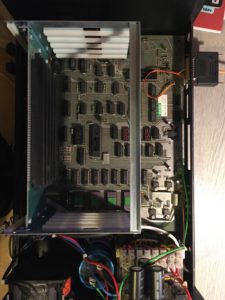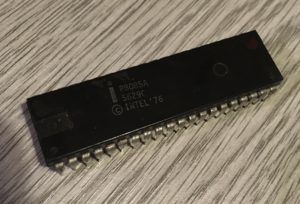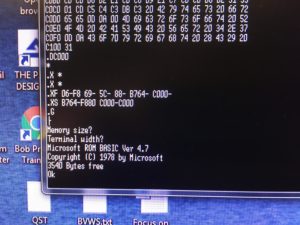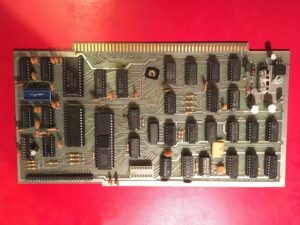Back in the mists of time, before mobile phones, flat screen TV, the internet and many of the modern technological marvels, personal computers were very much in their infancy. Many people I knew were playing with Motorola 6502 based computers; we used those at university in the form of a Rockwell AIM-65. I’d been working at the British Gas Engineering Research Station (ERS) in Killingworth, where they had standardised on the Intel 8085 processor and Intel SDK-85. So, instead of going down the Apple II route, I built a Netronics Explorer 85, which was of course, 8085 based and used the S100 bus.
 It got to the point of having a massive 64K of dynamic RAM and a floppy disc interface and controller. Later on I built a 10 slot S100 based machine with floppy drive, 5MB full height hard drive, colour graphics, real time clock, analog in and out, speech board etc.
It got to the point of having a massive 64K of dynamic RAM and a floppy disc interface and controller. Later on I built a 10 slot S100 based machine with floppy drive, 5MB full height hard drive, colour graphics, real time clock, analog in and out, speech board etc.
That was sold some 20 years ago to a chap in the USA…it cost as much to send it as I got for it. It would be worth somewhat more now and he got all my software discs.
I did keep the original Netronics Explorer 85 I built, complete with a JAWS 64K dynamic RAM board and Floppy 1-A board. Somehow I also have another built Explorer 85 Level A board, two new and unpopulated motherboards, an S100 card cage, a 64K JAWS RAM board plus a Wildern Electronics 8085 CPU board and a random 16K static RAM board.
Netronics are still in business, although it’s a different business; check them out here.
The Explorer 85 has its own Wikipedia page here.
INFORMATION: there is a link from the Wikipedia page to digital copies of the Netronics manuals and schematics; if you’re stuck and actually have a machine or one of the boards, I’ll be happy to help.
WANTED: I need the documentation for the Netronics Floppy 1-A board please.
 The Explorer 85 was available in the UK from a company called Newtronics (see advert above), so no similarity there then! My computer was purchased from a certain Gordon Douglas who lived on the outskirts of Leeds. Whilst I was at university, it was built and expanded…the 10 slot S100 machine came about later, when I was working. To the right is a picture of the computer without the JAWS dynamic RAM board installed.
The Explorer 85 was available in the UK from a company called Newtronics (see advert above), so no similarity there then! My computer was purchased from a certain Gordon Douglas who lived on the outskirts of Leeds. Whilst I was at university, it was built and expanded…the 10 slot S100 machine came about later, when I was working. To the right is a picture of the computer without the JAWS dynamic RAM board installed.
The computer has been stored for many years and I thought it was time to try and resurrect it, inspired by my friend Ross, who is an expert in older computer systems. Ross has the equipment and skills to transfer my bootable 8 inch disc to a 5.25 inch disc. It took a few goes because I suspect the old CDC 8 inch drive I created the original disc on, might have had minor alignment issues.
Making it work
The resurrection was relatively pain free:
 after checking for damage, corrosion and any other visual problems, the basic cabinet and motherboard were brought up slowly using a variac. The mains and DC voltages were all carefully monitored and critical components checked for overheating.
after checking for damage, corrosion and any other visual problems, the basic cabinet and motherboard were brought up slowly using a variac. The mains and DC voltages were all carefully monitored and critical components checked for overheating.- my PC uses Windows 7 and there is of course no serial Hyperterminal; Tera Term was therefore installed. I made up a lead for the RS232 communication, using my oscilloscope to trace the signal back to the 8085 SID line.
 the data wasn’t reaching the SID line, being blocked by a gate. I realised that the board was not running. On the Explorer 85, the red LED next to the tape relay should go out when the reset button is pressed, and come on again a second or so after the button is released…it was staying on. The scope also revealed that although the upper eight bit address lines for the CPU were active, the lower eight were flat-lined. I replaced the 8085 CPU with a new one, remade the reset link S17 on the motherboard, pressed RESET on Explorer 85, followed by the spacebar on my PC. It was heartwarming to see the Netronics sign on message appear. The system was responding to commands.
the data wasn’t reaching the SID line, being blocked by a gate. I realised that the board was not running. On the Explorer 85, the red LED next to the tape relay should go out when the reset button is pressed, and come on again a second or so after the button is released…it was staying on. The scope also revealed that although the upper eight bit address lines for the CPU were active, the lower eight were flat-lined. I replaced the 8085 CPU with a new one, remade the reset link S17 on the motherboard, pressed RESET on Explorer 85, followed by the spacebar on my PC. It was heartwarming to see the Netronics sign on message appear. The system was responding to commands. I set the 4K RAM address to start at 0000h and the BASIC-80 EPROM set to start at C000h. The stack pointer was set at F880h and the program counter to C000h. I pressed ‘G’ then hit enter, pressed enter a couple of times more to accept the memory defaults…and was greeted by the Netronics BASIC-80 sign on screen.
I set the 4K RAM address to start at 0000h and the BASIC-80 EPROM set to start at C000h. The stack pointer was set at F880h and the program counter to C000h. I pressed ‘G’ then hit enter, pressed enter a couple of times more to accept the memory defaults…and was greeted by the Netronics BASIC-80 sign on screen.- The 64K JAWS dynamic memory board was then tested fully. I filled the RAM with 00h then FFh plus a few others and all was well.
-
The next step is the Floppy 1-A controller…I have the schematic and layout. I also have the cables and a bootable (I hope) system disc on 5.25 inch floppy that thinks it’s an eight inch drive. I’m nearly there with this but there are some checks to do to get the baud rate and other things right.
I’ll keep you posted if you’re interested, and will update this page.
